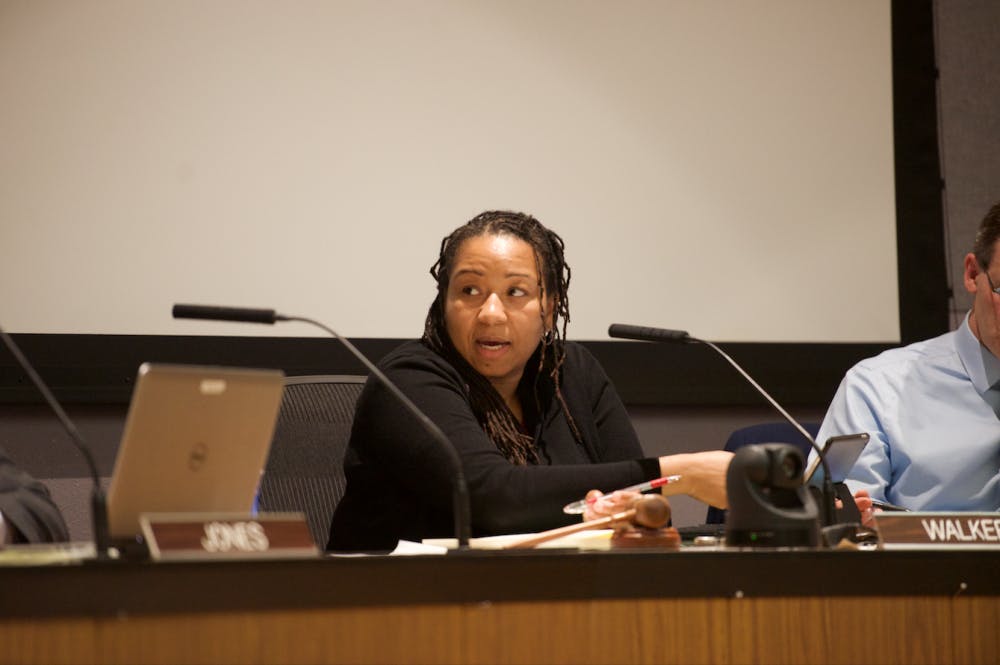The Charlottesville City Council considered the adoption of an ordinance at their meeting Tuesday to transfer ownership of Brandon Avenue to the University as part of a master plan developed by U.Va. to redevelop the area as a “green street” and connect the South Lawn complex to the U.Va. Health System.
In the currently proposed ordinance, the city would vacate all of its public interests in the Brandon Avenue area — as well as a portion of nearby Monroe Lane and 15th Street — to allow for site work to be completed in preparation for the redevelopment project. The title of the land — including the street itself and the adjacent sidewalks — would be transferred to the University for the construction of new buildings and other improvements to the area.
Under the Brandon Avenue Master Plan, the University intends to redevelop several properties along the street to construct a green student community which would include academic spaces, student wellness facilities, student housing and a central “green street.” A green street is an environmentally friendly roadway which utilizes vegetation, soil and engineered systems to efficiently collect and cleanse rainwater at its source rather than being culled into drainage ways from impervious surfaces.
Brandon Avenue is located off of Jefferson Park Avenue between the University’s South Lawn complex and the University Health System. The majority of the properties located along the street are already owned by the University or the UVA Foundation — a property and financial services extension of the University — and include the Elson Student Health Center and the Outpatient Surgery Center.
The Monroe Building, the Eunoia Christian Community and a small cemetery, however, are among privately owned properties on Brandon Avenue that the University will not have access to during the redevelopment process and will have to work around.
During Tuesday’s meeting, the Council discussed the merits of adopting the ordinance and spoke on its potential impact upon the local community.
Mayor Nikuyah Walker questioned what the current value of Brandon Avenue is. She said the University should compensate the city in some form if the street is vacated and allow the funds to be allocated towards an area of interest to the city, such as affordable housing.
City Manager Maurice Jones said the value of Brandon Avenue had not been assessed by the city but added that its market value would not be substantial after factoring in maintenance costs saved by the city from vacating the street.
“It’s a street right now, it probably remains a street in the future,” Jones said. “You wouldn't be getting necessarily market value for that, but there might be some minimal amount of money that it’s worth, and then you have to weigh that with the cost of maintaining that road as well, and I dont think youre going to get a lot of money out of that.”
Councilor Kathy Galvin said the redevelopment project would serve as a valuable asset to the city in terms of its environmentally efficient design. She added that it would reduce maintenance costs for the city as well.
“There is something to be said as well for the fact that the University will be then basically piloting a true green street which is something that has been talked about,” Galvin said. “I think it is valuable that the University will be doing this not at our expense, but at theirs.”
In response to Galvin, Walker said she would prefer to see concrete evidence of how the University will compensate the city.
“I would just like to know … How the University can contribute,” Walker said. “If that's [Brandon Ave.] being gifted to them for them to be able to see their vision, [is there] a way for them to contribute to the city and the sum of our needs here?”
Acting City Attorney Lisa Robertson said the currently proposed ordinance includes clauses which would require the University to structure the redevelopment of Brandon Avenue with the City’s Bicycle and Pedestrian Master Plan Vision Network. The University would also be responsible for covering the cost of relocating some city owned utility connections on Brandon Avenue.
“One of the requests staff has made is for there to be significant bicycle and pedestrian connections,” Robertson said.
Robertson added that such coordination between the City and University would serve as a form of compensation by the University.
“Whatever value we are looking at would be adjusted to the extent that there might be an easement in favor of the city in the same area that’s being proposed to be vacated,” Robertson said.
Councilor Mike Signer said the University's contribution to the city’s ongoing redevelopment of West Main Street also serves as a valuable contribution to the city which he equated with vacating Brandon Avenue to the University.
“If they're [the University] getting something valuable for them and just getting it for free, and there's no negotiation, that would seem odd perhaps,” Signer said. “My perception is that they did in fact decide … To step up and contribute significant monies to the capital costs of the bikes and the lights of the $35 million West Main streetscape, and those are linked in a way because they both have to do with streets and that area.”
Further discussion and a final vote on the proposed ordinance by the Council will take place at the body’s next meeting. In the meantime, Jones said the City will direct staff to assess the value of Brandon Avenue and consider ways the University could further contribute to the city.







